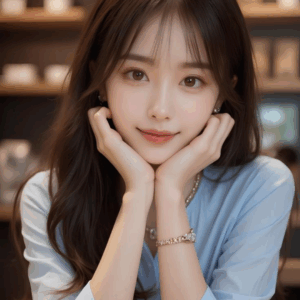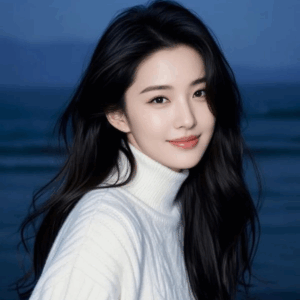Delving into Virtual Glamour: AI-Generated Beauties from East to West, this introduction immerses readers in a unique and compelling narrative that explores the concept of virtual glamour and its cultural influences from East to West. From the evolution of virtual glamour to the technology behind AI-generated beauties, this topic provides a captivating overview that sparks curiosity and discussion.
Overview of Virtual Glamour
Virtual glamour refers to the concept of creating aesthetically pleasing and visually appealing digital representations of beauty using artificial intelligence (AI) technology. These AI-generated beauties can be customized to embody idealized standards of attractiveness, blending characteristics from different cultures and regions to create a unique virtual persona.
Cultural Influences in AI-Generated Beauties
AI-generated beauties draw inspiration from a diverse range of cultural influences, blending elements from both Eastern and Western aesthetics. From the delicate features common in East Asian beauty standards to the bold and expressive characteristics often associated with Western ideals, virtual glamour embraces a fusion of cultural traits to redefine beauty in the digital realm.
Evolution of Virtual Glamour in Different Regions
The evolution of virtual glamour varies across different regions, with each culture contributing its own unique perspective on beauty and aesthetics. In the East, virtual beauties may reflect traditional notions of elegance and grace, while in the West, they may embody modern trends and avant-garde expressions of beauty.
This diversity in regional influences has led to a rich tapestry of AI-generated beauties that cater to a global audience with varying preferences and tastes.
Technology Behind AI-Generated Beauties

AI algorithms play a crucial role in creating virtual beauties, combining computer vision, machine learning, and deep learning techniques to generate realistic and visually appealing models. These technologies analyze massive datasets of human faces, identifying patterns and features to replicate in virtual characters.
Comparison of AI Technologies in East and West
In the East, particularly in countries like Japan and South Korea, AI technologies focus on enhancing natural beauty standards, with a preference for soft features and flawless skin. On the other hand, in the West, AI-generated beauties often emphasize diversity and individuality, celebrating unique facial characteristics and expressions.
- East: AI algorithms prioritize symmetry, smooth skin, and delicate facial structures, aiming for a harmonious and refined look.
- West: AI technologies embrace diversity in facial features, skin tones, and expressions, reflecting a broader range of beauty standards and cultural influences.
Role of Machine Learning and Deep Learning in Virtual Glamour
Machine learning algorithms enable AI systems to learn from data, making predictions and decisions based on patterns and trends. Deep learning, a subset of machine learning, uses neural networks to process complex data and extract features, allowing for more sophisticated and nuanced representations of virtual beauties.
Deep learning algorithms can analyze thousands of facial images to understand intricate details like eye shape, skin texture, and hair color, improving the realism of AI-generated characters.
Cultural Representations in AI-Generated Beauties

In the realm of AI-generated beauties, cultural norms and beauty standards play a significant role in shaping the design and representation of virtual models. These digital creations are influenced by a diverse range of cultural influences, reflecting the global nature of beauty ideals.
Influence of Cultural Norms on AI-Generated Beauties
Cultural norms heavily impact the design of AI-generated beauties, as these virtual models are often created to appeal to specific cultural aesthetics and preferences
. For example, AI beauties designed in East Asia may embody traditional ideals of beauty such as porcelain skin, delicate features, and long dark hair, reflecting the cultural standards of beauty in that region.
Diversity in Representations of Beauty Across Cultures
AI-generated beauties showcase a wide range of beauty standards across different cultures, highlighting the diversity and uniqueness of beauty ideals worldwide. From the ethereal elegance of Japanese geishas to the bold and vibrant beauty of Brazilian carnival dancers, these virtual models celebrate the rich tapestry of beauty across the globe.
Impact of Cultural Perceptions on Society’s Acceptance of AI Beauties
Cultural perceptions play a pivotal role in determining the acceptance of AI beauties in society. Depending on how well these virtual models align with cultural beauty standards, they may be embraced or met with skepticism. By incorporating a diverse range of cultural representations in AI-generated beauties, developers can foster greater acceptance and appreciation for these digital creations.
Ethical Considerations in Virtual Glamour

As AI technology continues to advance, the use of AI-generated beauties raises important ethical considerations that need to be addressed. The creation of virtual models brings up issues surrounding objectification, consent, and stereotyping that must be carefully examined.
Objectification in Virtual Beauties
One of the primary ethical concerns with AI-generated beauties is the potential for objectification. These virtual models are designed to represent an idealized version of beauty, which can perpetuate unrealistic standards and contribute to the objectification of individuals, particularly women.
It is essential to consider the impact of portraying AI-generated beauties solely for aesthetic pleasure, without acknowledging the complexity and humanity of real individuals.
Consent and Representation
Another critical ethical issue is the concept of consent in using AI-generated models. These virtual beauties are created without their explicit consent, raising questions about the ethical implications of using their likeness for commercial or entertainment purposes. Additionally, the representation of diverse cultures and identities in AI-generated models must be approached with sensitivity to avoid reinforcing harmful stereotypes or biases.
Addressing Ethical Concerns
To promote responsible use of virtual glamour technology, it is crucial to implement ethical guidelines and standards for creating and utilizing AI-generated beauties. This may include ensuring transparency in the creation process, obtaining consent from individuals whose likeness is used, and actively working to challenge stereotypes and promote inclusivity in virtual representations.
By prioritizing ethical considerations, we can harness the potential of AI technology in a way that respects the dignity and diversity of all individuals.
Epilogue
In conclusion, Virtual Glamour: AI-Generated Beauties from East to West offers a fascinating journey through the intersection of technology, culture, and ethics in the realm of virtual beauty. From analyzing cultural representations to addressing ethical considerations, this discussion opens doors to further exploration and reflection on the impact of AI in shaping beauty standards.
FAQ Corner
How are AI algorithms used in creating virtual beauties?
AI algorithms are utilized to analyze facial features, skin tone, and other characteristics to generate lifelike virtual beauties.
What is the role of machine learning in virtual glamour?
Machine learning plays a crucial role in training AI models to recognize patterns and create realistic virtual beauty representations.
How do cultural norms influence the design of AI-generated beauties?
Cultural norms impact the perception of beauty, influencing the design choices in AI-generated beauties to reflect diverse cultural standards.
What ethical implications arise from using AI to create virtual beauties?
Ethical concerns include issues of objectification, consent, and stereotyping, raising questions about responsible use of virtual glamour technology.
 AI algorithms play a crucial role in creating virtual beauties, combining computer vision, machine learning, and deep learning techniques to generate realistic and visually appealing models. These technologies analyze massive datasets of human faces, identifying patterns and features to replicate in virtual characters.
AI algorithms play a crucial role in creating virtual beauties, combining computer vision, machine learning, and deep learning techniques to generate realistic and visually appealing models. These technologies analyze massive datasets of human faces, identifying patterns and features to replicate in virtual characters.
 In the realm of AI-generated beauties, cultural norms and beauty standards play a significant role in shaping the design and representation of virtual models. These digital creations are influenced by a diverse range of cultural influences, reflecting the global nature of beauty ideals.
In the realm of AI-generated beauties, cultural norms and beauty standards play a significant role in shaping the design and representation of virtual models. These digital creations are influenced by a diverse range of cultural influences, reflecting the global nature of beauty ideals.
 As AI technology continues to advance, the use of AI-generated beauties raises important ethical considerations that need to be addressed. The creation of virtual models brings up issues surrounding objectification, consent, and stereotyping that must be carefully examined.
As AI technology continues to advance, the use of AI-generated beauties raises important ethical considerations that need to be addressed. The creation of virtual models brings up issues surrounding objectification, consent, and stereotyping that must be carefully examined.











